- Communauté HubSpot
- RevOps & Operations Hub
- 📝 Resources
- 5 Tips for Creating a Lead Scoring Model that Actually Works
📝 Resources
- S'abonner au fil RSS
- Marquer comme nouveau
- Marquer comme lu
- Marquer
- S'abonner
- Page imprimable
- Signaler un contenu inapproprié
- S'abonner au fil RSS
- Marquer comme nouveau
- Marquer comme lu
- Marquer
- S'abonner
- Page imprimable
- Signaler un contenu inapproprié
5 Tips for Creating a Lead Scoring Model that Actually Works
Lead Scoring is one of those things in HubSpot that, in theory, sounds really technical and sophisticated. After all, you're telling me I can create a process that will judge my leads for me? Sounds like a great opportunity to teach HubSpot to qualify my leads how I would!
But in practice, Lead Scoring can be over-engineered to the point of counter-productivity. Sometimes, we focus so much on what Lead Scoring is able to do, that we miss the mark on setting it up to do what it should be doing — catching the little nuances in our marketing process that qualify someone for MQL status.
The goal of lead scoring is neither to make it hard nor easy for leads to qualify for MQL status. Rather, it's to capture a series of behaviors that accurately tell us a story about where the prospect may be in their buying journey, and when it's appropriate to reach out.
In this blog, we'll discuss some tips to help create a lead scoring strategy that feels organic, easy to manage, and can help your sales team trace back a prospect's story leading up to MQL status.
Tip 1: Separate your direct MQL qualifiers into lists
Any criteria that directly qualifies someone for MQL status should go into a designated MQL list. This way, we can leverage workflows and emails to automate things like a contact's lifecycle stage changing to MQL, reps being notified that their lead just hit this status, and anything else you want to respond with to someone's new status in your database. By creating a process centered on clean data, efficient communication, and less work— you can't go wrong.
Below are some examples of criteria you'd bring out of your lead scoring model and into your list:
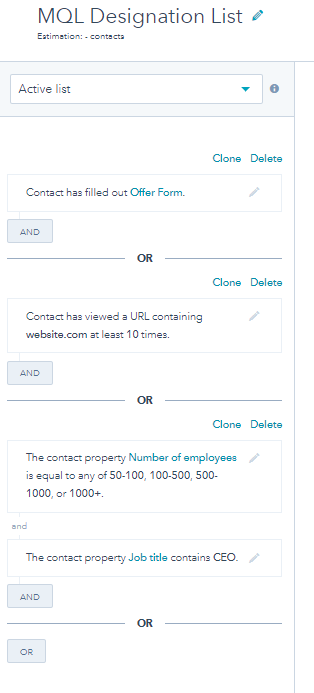
To finish implementing this tip you'll want to create a workflow that maps lifecycle stage to your MQL list membership, as detailed below:
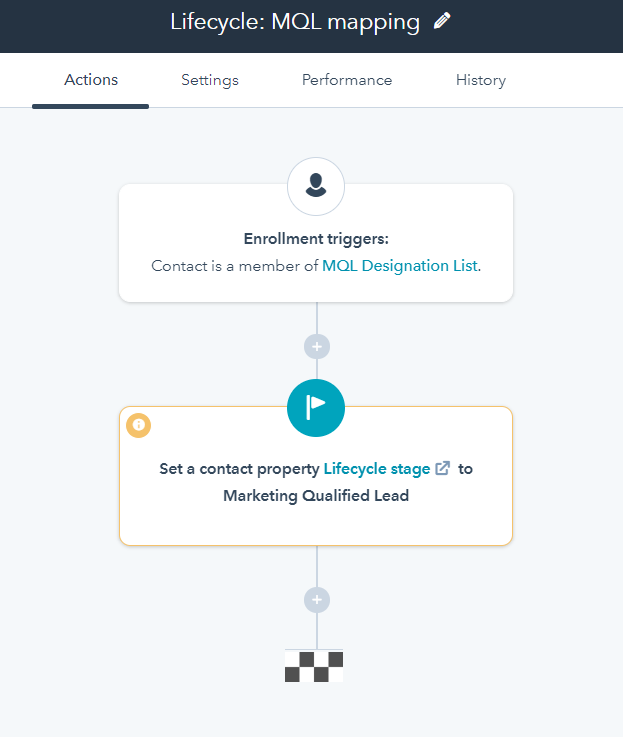
With this in place, we can reliably generate MQLs based on big-ticket items like contact forms, while we use lead scoring to start qualifying everyone else who is engaging in smaller ways over time.
Tip 2: Keep your score ranges small
A lead scoring model shouldn't have anything worth an exorbitant amount of points for the purpose of directly qualifying. We'll be working with smaller ranges whose lower, middle and upper limits allow for easy interpretation. A lot of folks will use 0-10, but even that may be too big. What does it mean for a contact to land on a score between 3-7? A scale of 1-5 may be more appropriate since there's a clear line between not-so-good (1-2), okay (3), and great (4-5)!
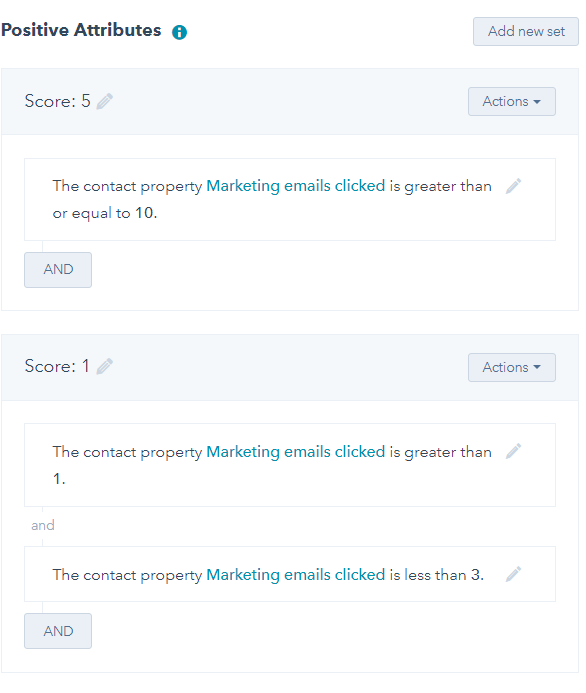
Having a smaller scale makes it easy to identify what makes a good action different than a great one, and helps us work smarter with Tip #3.
Tip 3: Assign your entire score range to different iterations of the action
Your lead scoring model should allow your contact to reach certain milestones no matter what combination of smaller actions they take, especially taking into account the frequency or quantity of these actions. A contact that has opened 10 emails and visited your page 10 times should be prioritized just as much as a contact who has downloaded 2 whitepapers if you find that the conversation is the same. Allowing your contacts to accumulate points based on iterations of the same action enables you to do this. If we take the example used in Tip 2 and create a range to measure our contacts' engagement by email clicks, the scale entry into our lead scoring model looks like this:
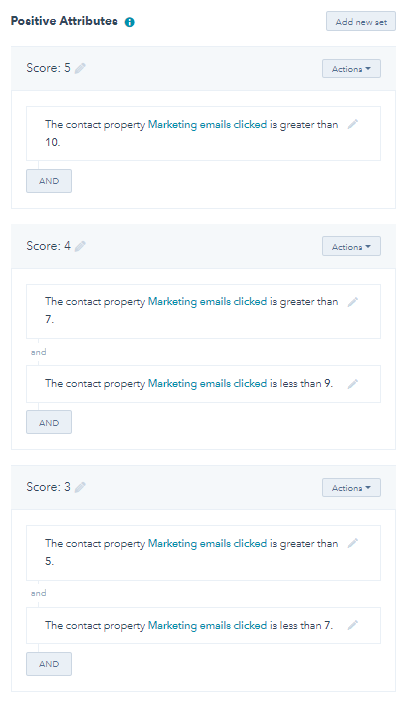
With this in place, our contact can accumulate a total of 15 points (1+2+3+4+5) by being a very engaged email user. Depending on what our final range is that can be very significant, and for good reason! Users who are highly engaged with our emails are ones we want to keep an eye on.
Replicate this example as many times as you want with other metrics. The beauty of this model is that you don't need that many metrics to tell a story. If we were to take the above approach and create a second set of scores for page visits, and a third for awareness-stage conversions, we'd have more than enough to qualify leads with!
Tip 4: Make your maximum score the addition of all your scores
In our last tip's example, I mentioned using 2 other metrics for a total of 3 KPIs we're looking at to determine MQL status. If we run with that, considering each score set is worth a max of 15 points, we're looking at a maximum score of 45 for our scoring model.
Regardless of where we draw our MQL cutoff on that range, one thing is for sure: our contacts will be able to meet our MQL criteria by accumulating points on any mix of criteria. 6 clicked emails and 10 page visits may qualify one person. 1 conversion, 5 page visits, and 2 emails clicked may qualify another.
When we make the range we're working with the addition of all points, we're able to stay nimble and accurate with our scoring model while being able to easily interpret the milestones.
Tip 5: Segment your maximum range into 3 parts
Although in our last tip I mentioned a maximum range, it's important to note that there's nowhere in the tool where this is enforced. However, using lists we can materialize our scoring range for things like lifecycle mapping and marketing segmentation.
In order to do this, we benefit from dividing our range into parts that represent what meeting a certain score means for the contact's status in the database. I'm a big fan of dividing lead score ranges into 3 parts: "Leads in need of nurturing," "Engaged Leads," and "Lead Score MQLs."
Using our example with a max range of 45, we'll set our "Leads in need of nurturing" cutoff at 10 points. Anything above that will belong in our "Engaged Leads" list from scores 11-35, and our "Lead Score MQL" list will contain contacts with scores 36-45. They'll look a little like this:
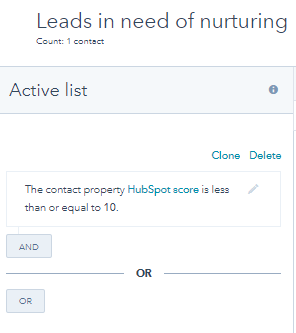
Labeling a contact as a new/nurturing lead lets us know, based on their low score, that we could stand to send a few more emails, offers, etc. For these contacts, consider adding them into a blog subscription list if you have an active blog, or something with some top-of-the-funnel content offers, along with some purely educational material.
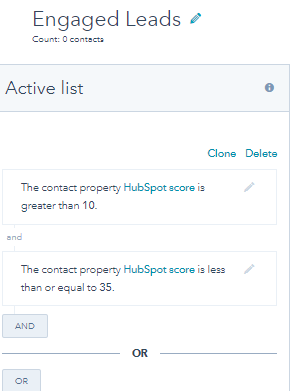
Labeling a contact as "engaged" means that they've reached a certain threshold of interacting with your content where it makes sense to start getting a bit more personal with offers, e.g. webinars, event invites, and more advanced conversion offers make sense for this contact.

Labeling a contact as "Marketing Qualified" means, through a series of interactions with marketing collateral, your client has indicated enough of an interest in your company where it makes sense for a sales rep to reach out. You can also refer back to the workflow in Tip 1 and add membership to our "Lead Score MQL" list as an "OR" criteria. This way, any leads that hit this HubSpot Score can have their lifecycle automatically changed to MQL.
These are only ideas, of course, once you have your lead scoring model and the appropriate lists to reference, you'll be able to create all sorts of workflows, internal notifications, and nurturing processes.
I hope this post has helped you configure a successful lead scoring model you can depend on. As you're trying the strategy out, feel free to comment or email me with any successes, ideas for improvement, or questions!
- [WRAP UP] RevOps with HubSpot Summer School
- [Case Study] Botkeeper Saves $100Ks With the HubSpot CRM Platform
- A Special Someone Turned One Last Month
- [Case Study] Katapult Earns Consistent 4.4 Reviews with the Help of The HubSpot Platform
- Alignment Eats Strategy for Breakfast
- [WRAP UP] Becoming a HubSpot Admin - 5 Lessons Learned from a HubSpot Admin
- [WRAP UP] Becoming a HubSpot Admin - 5 Tips from a RevOps Recruiter
- Power Up Your Other Hubs with Operations Hub
- [Case Study] ResellerRatings Increases New Customer Growth by 60%
- [Case Study] How ConstructConnect uses Operations Hub to Automate Flywheel Content
Pour ajouter un commentaire ici, vous devez être inscrit. Si vous êtes déjà inscrit, connectez-vous. Dans le cas contraire, inscrivez-vous puis connectez-vous.